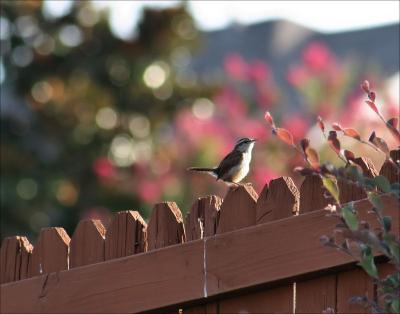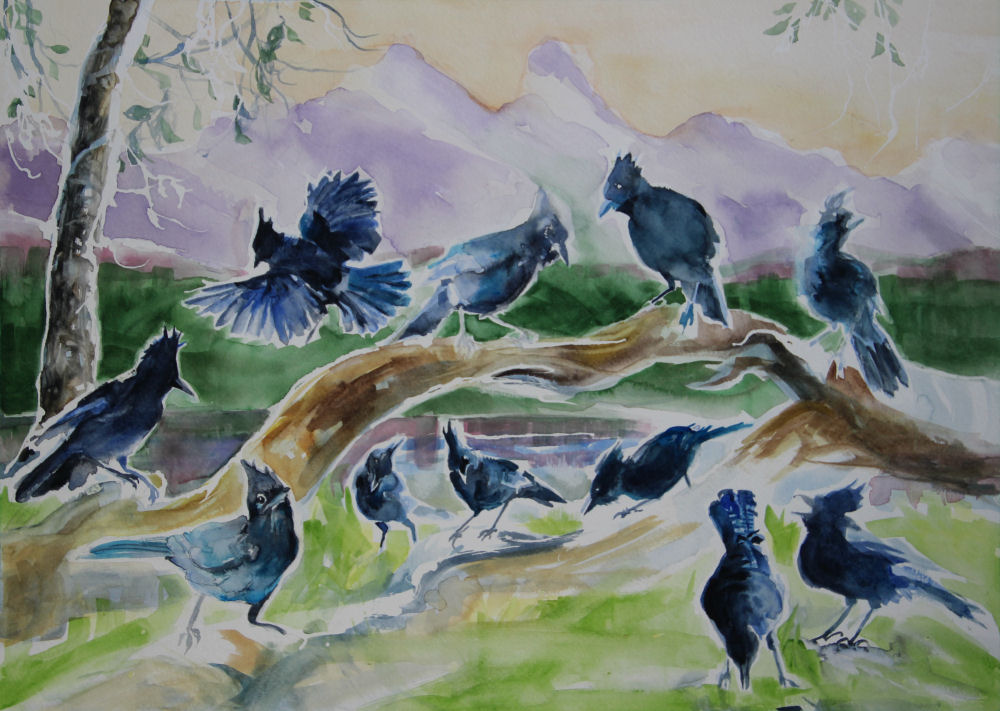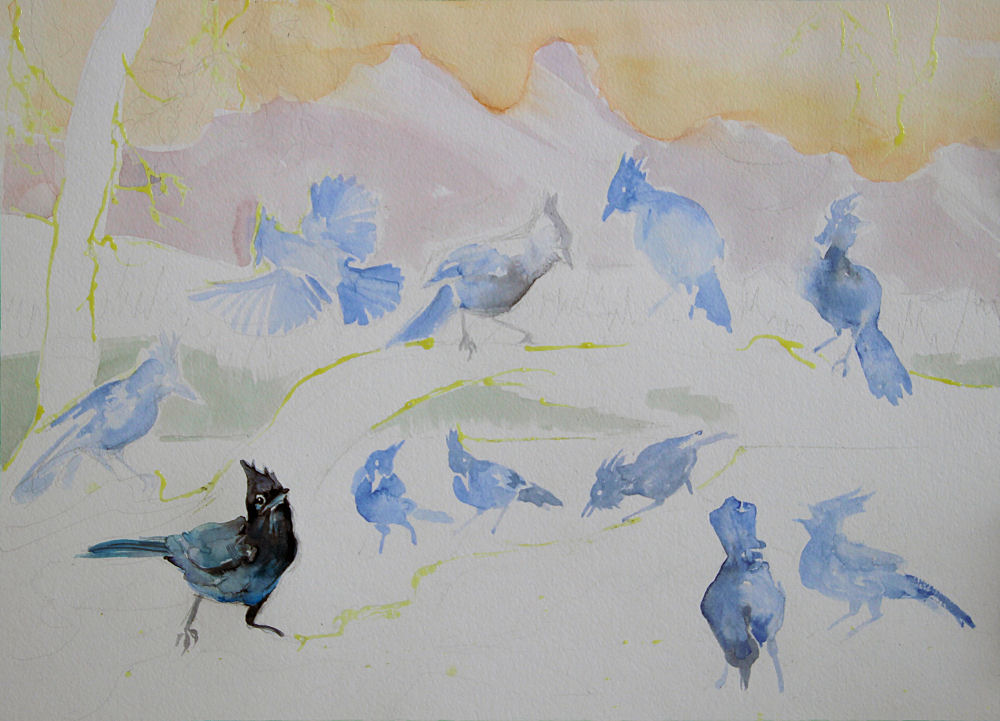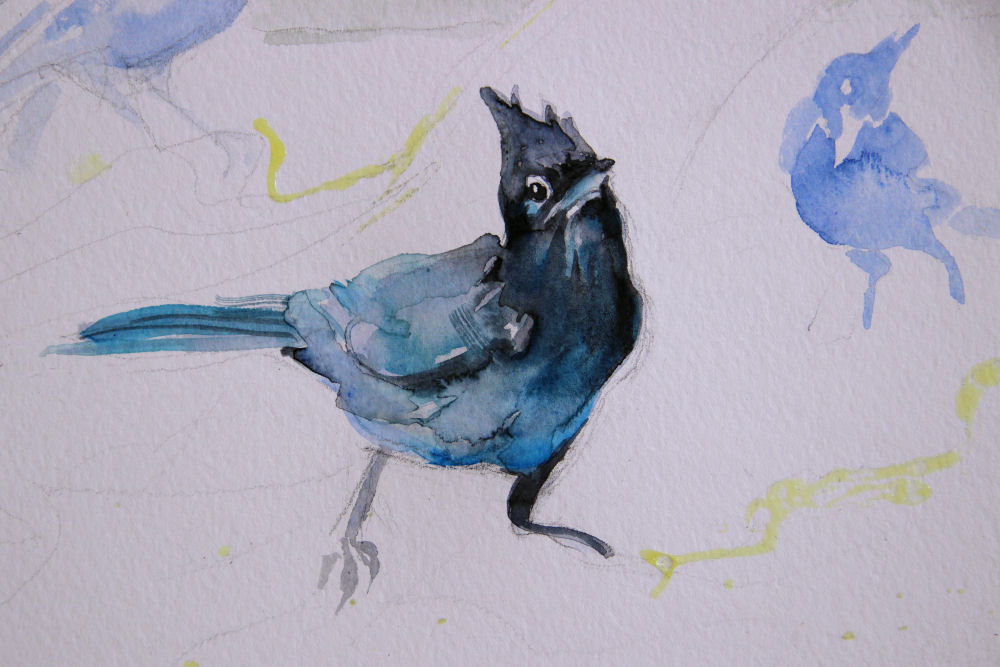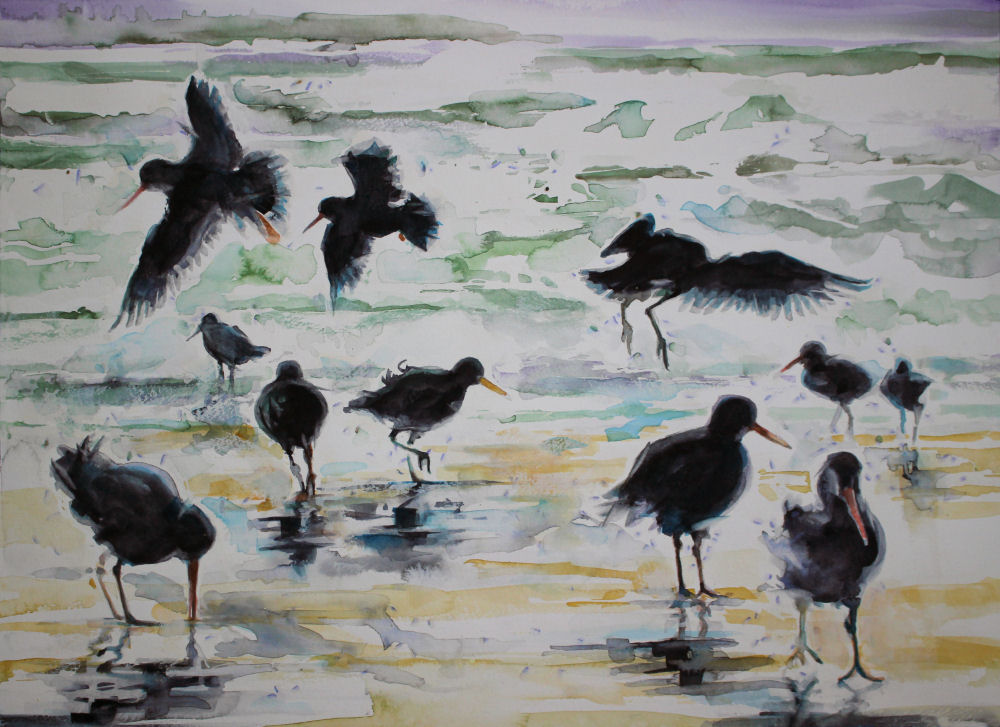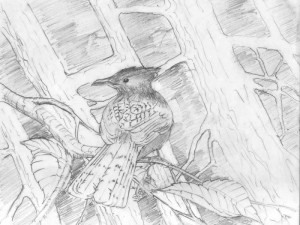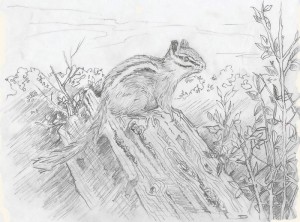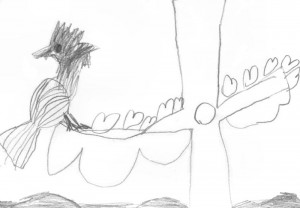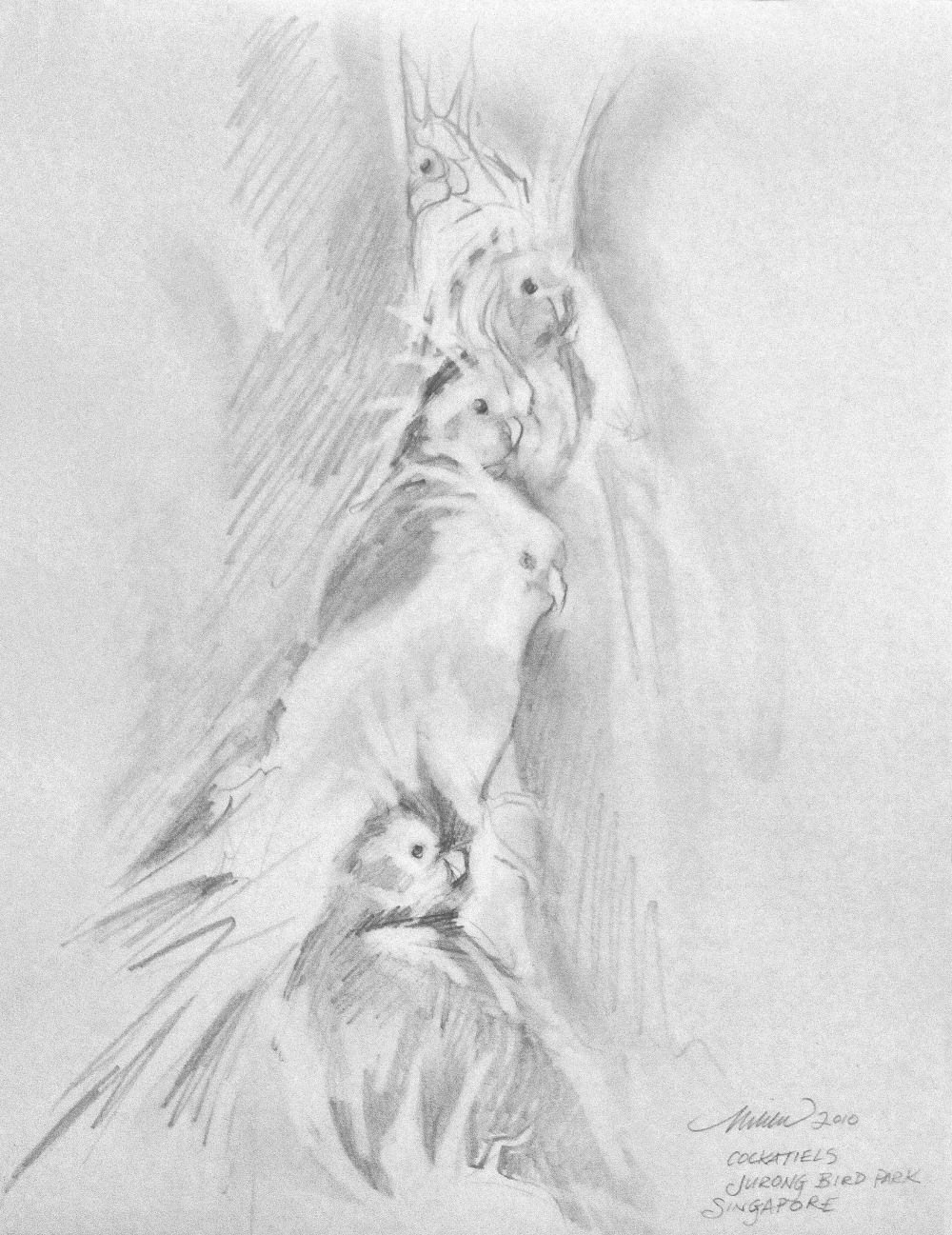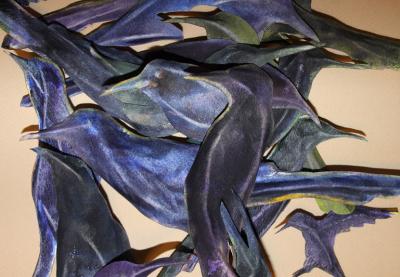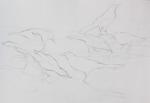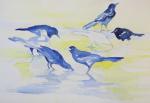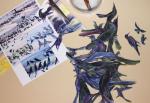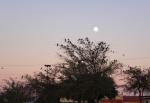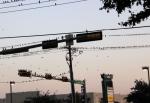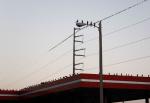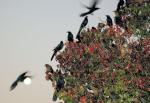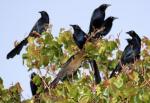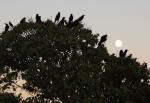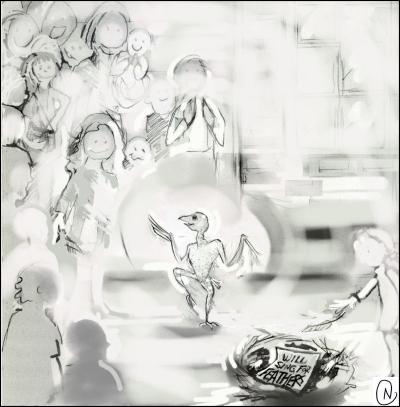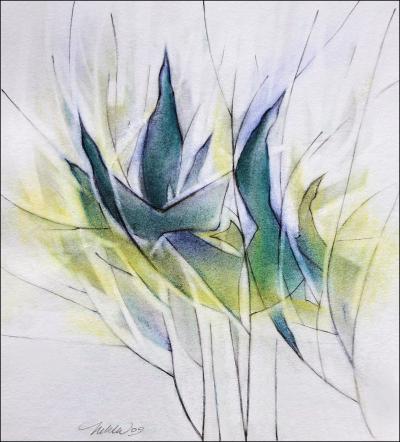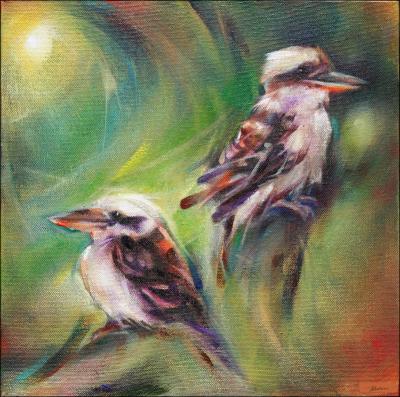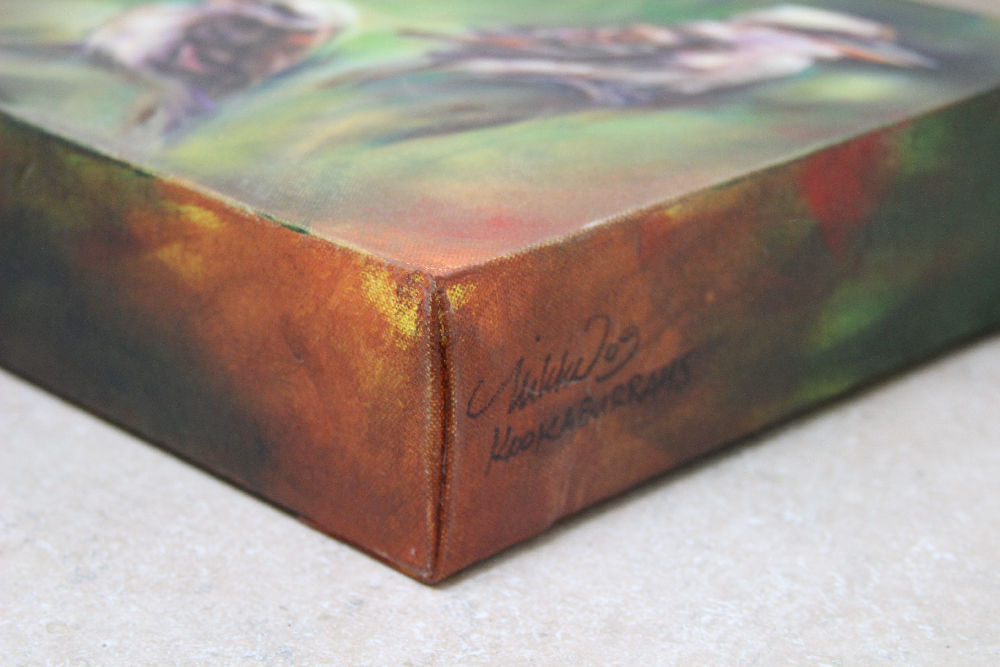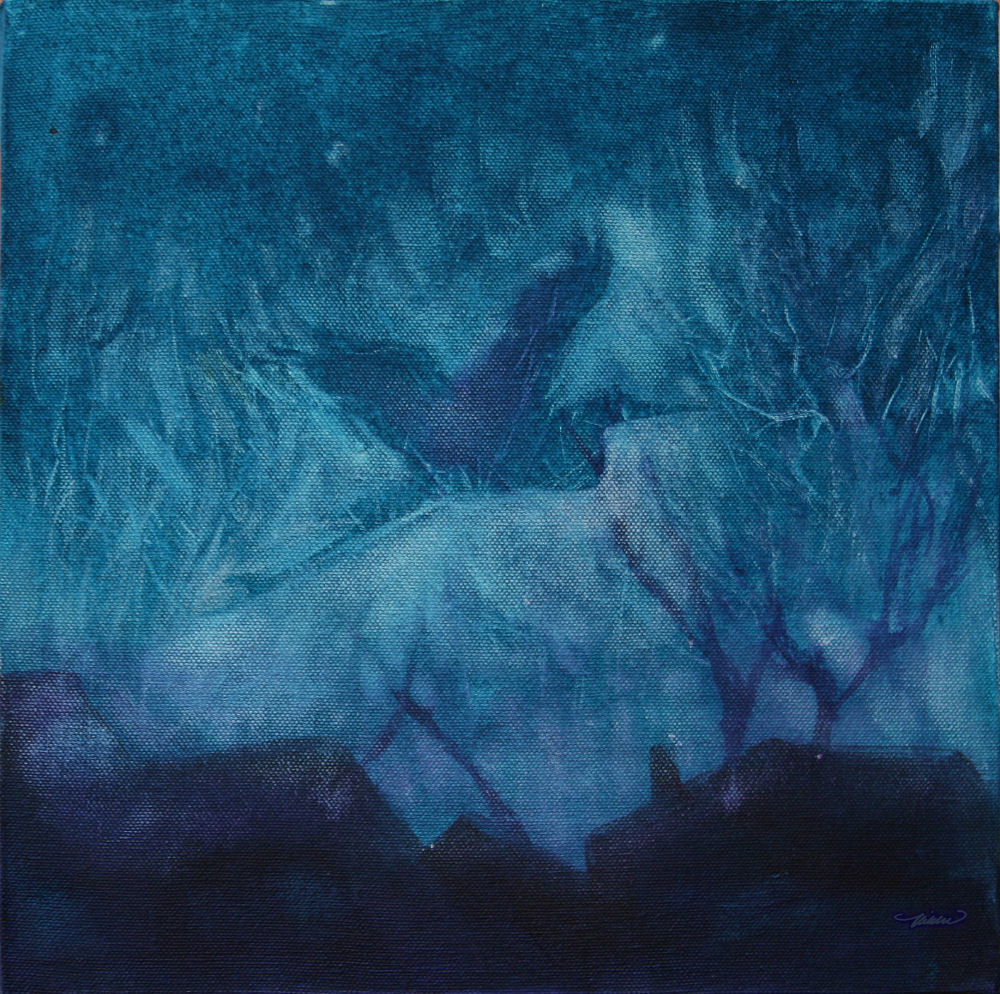birds
« Previous Entries Next Entries »Stellar’s Jays
Monday, April 17th, 2017
Work in progress, Stellar’s Jays at Nimkish Lake, Vancouver Island BC, 18 x 24 inches watercolors on 140 lb. cold press. For years I’ve been visualizing a painting that portrays the Stellar’s Jay in various poses, representing general character. My Dad pointed out that Stellar’s Jays don’t usually group this way, which is an accurate view of the broader behaviour that didn’t even occur to me. Interesting! Phase 02 below and detail image – the yellow is masking medium:
Normally I don’t outline anything when starting a painting, which works fine with acrylics because it’s easy to change things throughout the process, but watercolors don’t allow for much room for error, especially if you don’t have much practice with them. Wingin’ it usually works for me because I don’t mind failure in exchange for experience, but mapping out the shapes and arrangement lightly in pencil really helps, and confidence is fundamental to painting well.
Oystercatchers
Monday, February 27th, 2017
Oystercatchers, 18H x 24W inches watercolors on 140 lb cold pressed. Framed size 27H x 33W inches, white mat, white wood frame with crackle finish.
Showcased in the J. Mane Gallery’s Fins, Feathers and Fur 2020 exhibition.
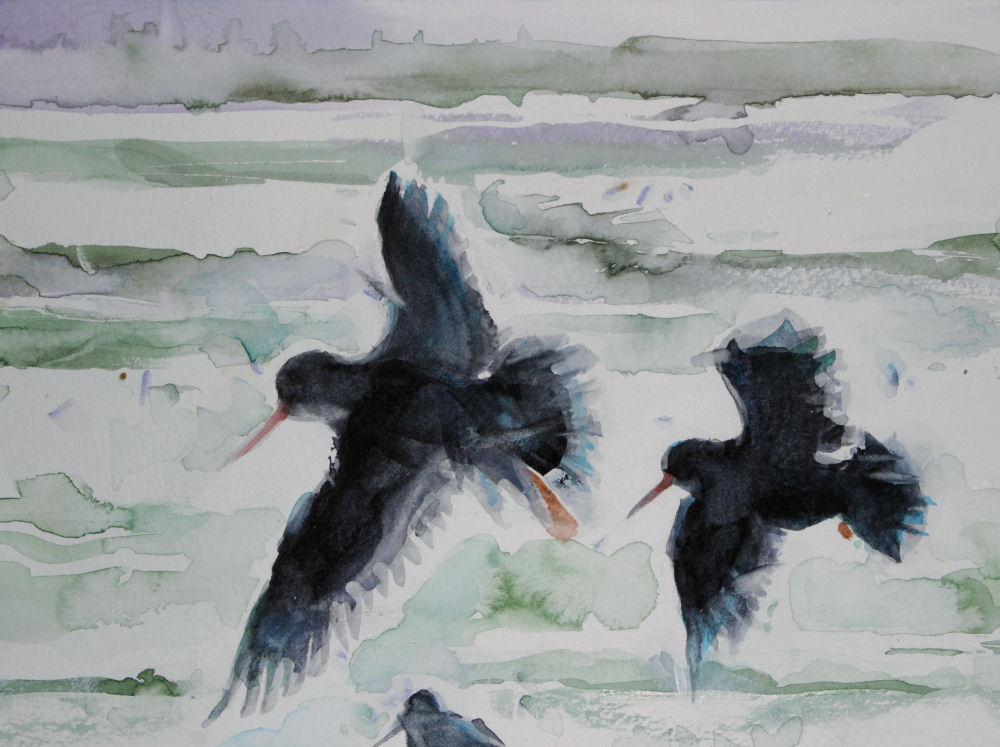 This is finished, although I’d love to merge the contrasts somehow. I don’t want to mess up the implied light though, or the initial spontaneous brush strokes, like in the background waves. Every new mark at this stage makes a difference too, and in context to the whole, even small changes affect other areas that need to adjust accordingly.
This is finished, although I’d love to merge the contrasts somehow. I don’t want to mess up the implied light though, or the initial spontaneous brush strokes, like in the background waves. Every new mark at this stage makes a difference too, and in context to the whole, even small changes affect other areas that need to adjust accordingly.
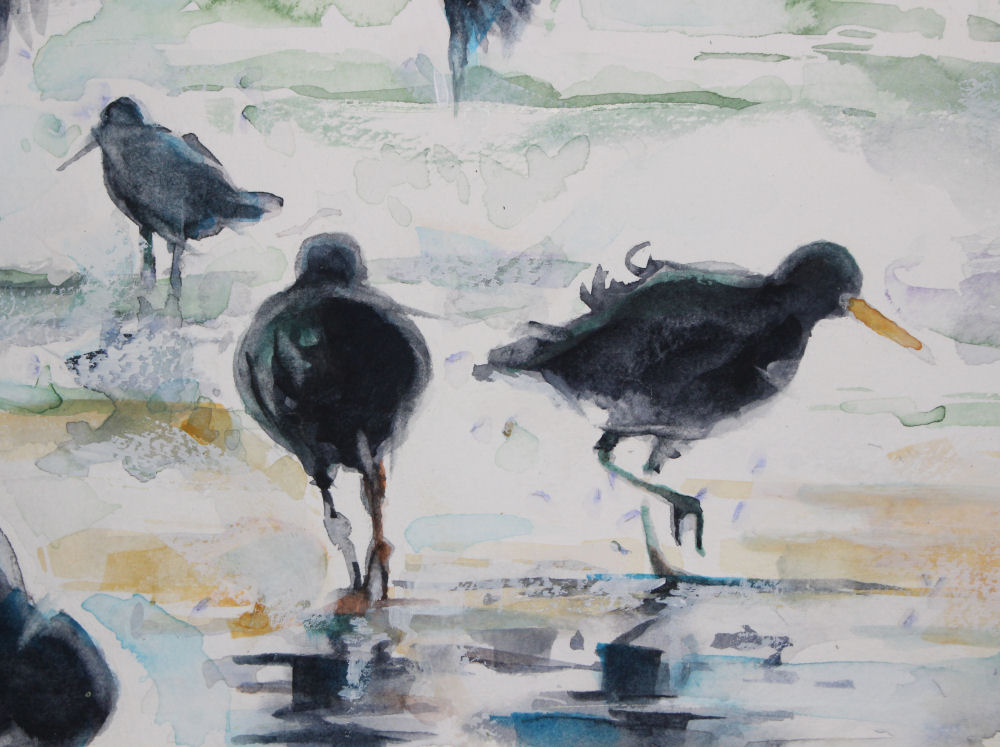 Before you know it, colors mud together and beautiful open spaces disappear. I’m going to take direction from my most recent pieces, which I feel were over-worked, and quit while I’m ahead.
Before you know it, colors mud together and beautiful open spaces disappear. I’m going to take direction from my most recent pieces, which I feel were over-worked, and quit while I’m ahead.
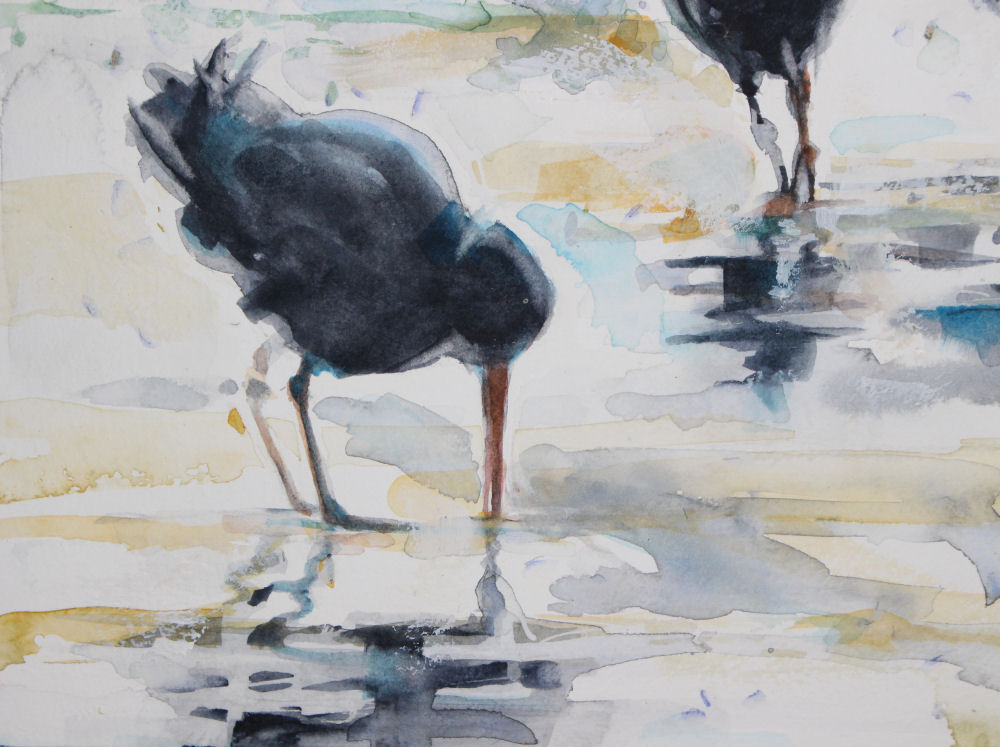 Challenge is exciting…particularly with watercolors. Whereas with other media mistakes can be erased or covered easily and change can occur throughout the process without much hesitation, with watercolors a person needs to know a subject well – or at least be able to fake it with confidence!
Challenge is exciting…particularly with watercolors. Whereas with other media mistakes can be erased or covered easily and change can occur throughout the process without much hesitation, with watercolors a person needs to know a subject well – or at least be able to fake it with confidence!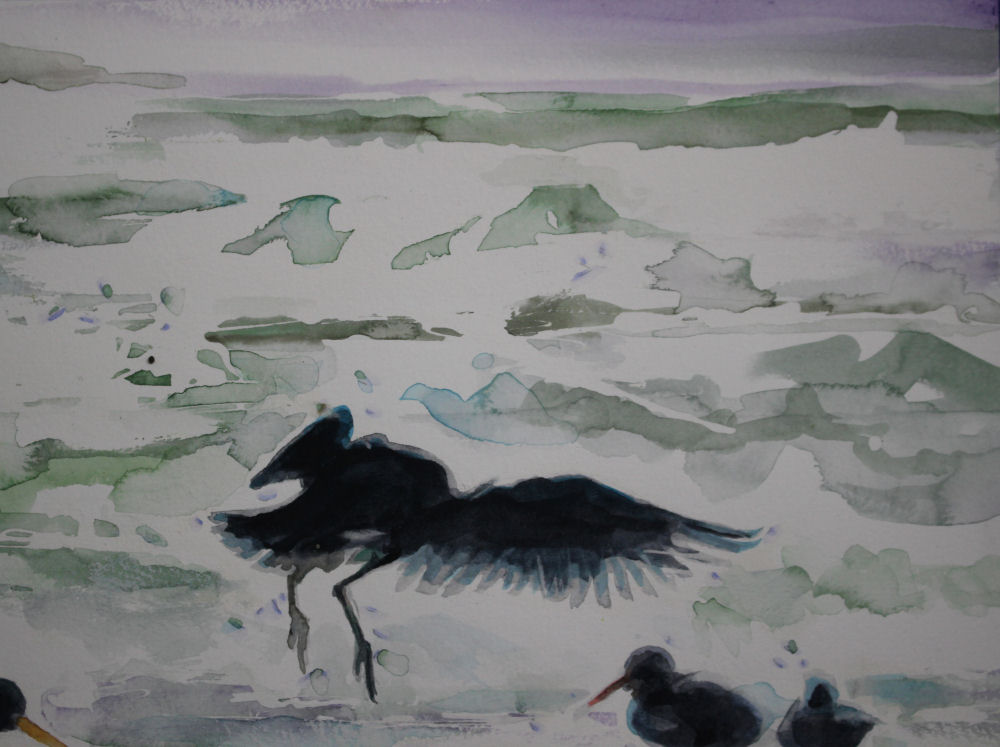
Finding a way to make each painting unique means following cues happening within the work itself. In this painting, the most remarkable thing occurred after the the first phase of production.
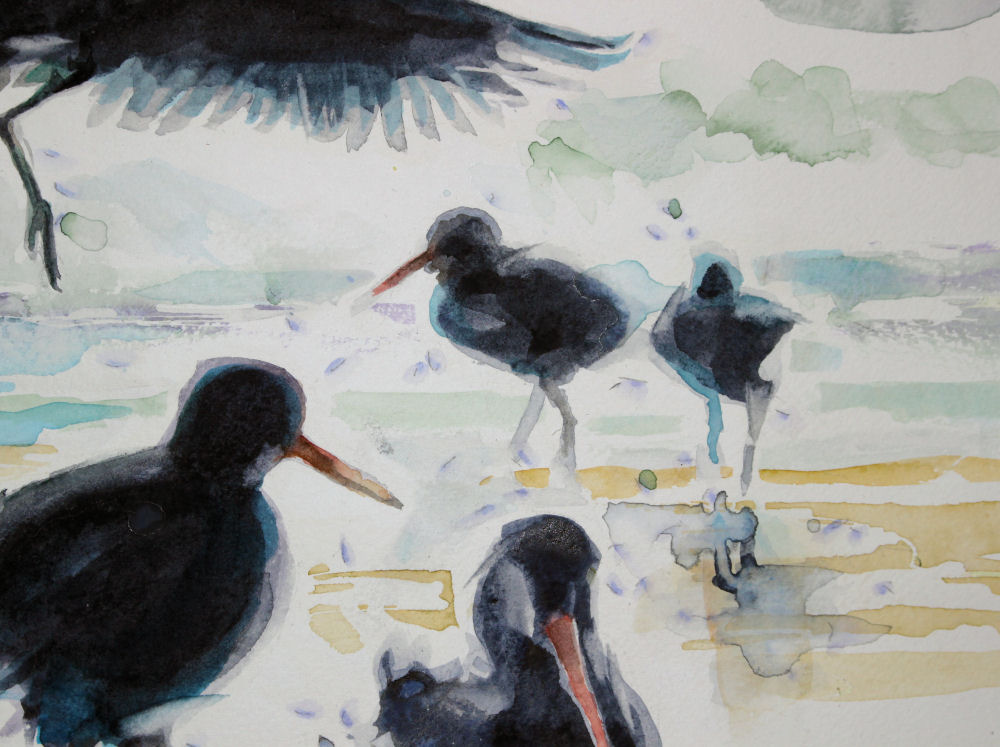 Because this subject was unfamiliar, I started by first penciling in the shapes, wondering what I could do to make this less boring – you know, not just be a picture of Oystercatchers. When erasing the pencil marks in order to see what the paint had established, little rolls of eraser pieces scattered here and there. Sprinkled impromptu around the birds, those tiny eraser shreds added a pronounced and unexpected zing of life to the composition.
Because this subject was unfamiliar, I started by first penciling in the shapes, wondering what I could do to make this less boring – you know, not just be a picture of Oystercatchers. When erasing the pencil marks in order to see what the paint had established, little rolls of eraser pieces scattered here and there. Sprinkled impromptu around the birds, those tiny eraser shreds added a pronounced and unexpected zing of life to the composition.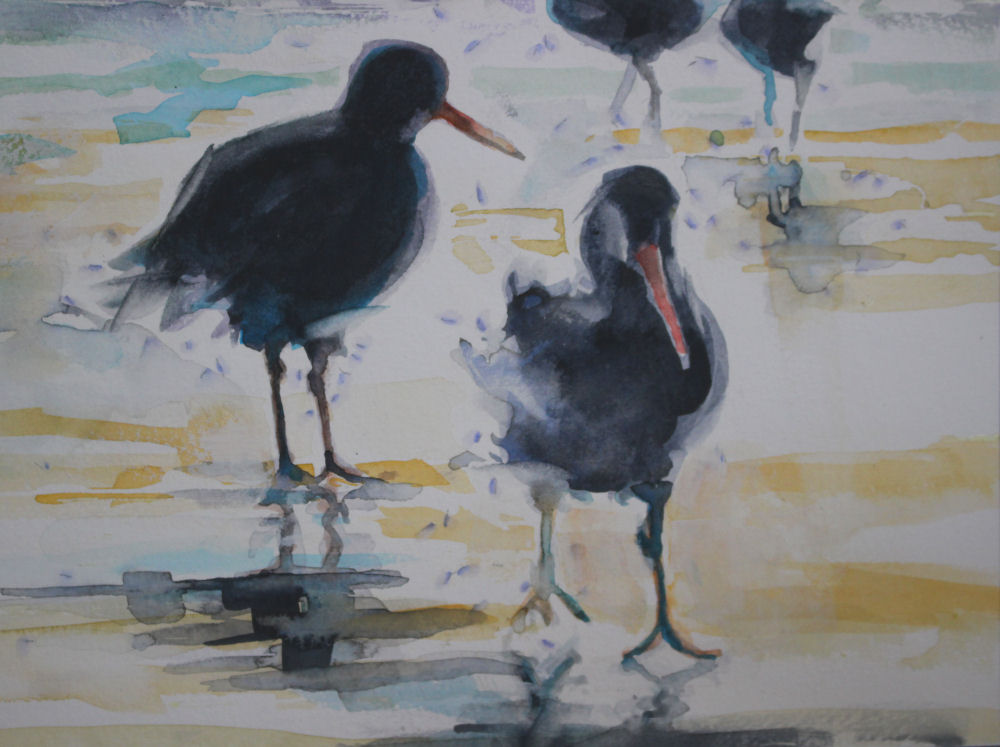 First thinking “what have I got to lose?”, the eraser-pieces were mimicked in paint around the birds. I’m tempted to make those strokes more prominent, but a small success is in order, so will use this fun technique in another painting.
First thinking “what have I got to lose?”, the eraser-pieces were mimicked in paint around the birds. I’m tempted to make those strokes more prominent, but a small success is in order, so will use this fun technique in another painting.
Influence
Monday, November 29th, 2010
“Some of us loved to draw when we were very young and many didn’t, but we are all capable. There is something to be said for innate abilities, but talent alone will not help us to advance. You might inherit Grandpa’s artistic genes, but every talent needs continual development to become skill no matter what it is, and drawing is no different than learning to play an instrument or climbing a mountain in that respect…” (excerpt from the article “Extreme Drawing“).
My father was a wood carver for most of his life, and his love for drawing was crucial to designing all the different things people ordered. Any time he taught woodcarving, he first insisted on lessons in drawing.
As it provided the funds necessary to build a house after a career the Canadian Armed Forces, there was almost nothing he wouldn’t carve; an entire range of subjects from detailed Armed Forces crests, modern abstract pieces, as well as birds and animals. My favorites were the custom designed doors, cupboards and headboards made for clients in Canada and the U.S. before retiring in 2002. Well, artists never really retire, they just keep moving on to try new things!
Photography has always been one of his passions, and he’s the real die-hard kind that will sit in mosquito-infested forests waiting forever for the right shot. One time he climbed a tree to capture photos of a porcupine, then fell out and sprained both his ankles. I was about nine years old, and I remember my Mom, my brother and me holding him up while he hobbled back to the car! Here is some of his recent photography, and lately he’s been taking the time to enjoy drawing again.
My Mom was an equal and supporting partner in the creating and finishing details of all the wood work they sold. Though my mother claims to not know how to draw, they have both been, and continue to be, huge influences as far as my being an artist. When I was quite young I would ask my Mom to draw anything so I could color it. I did care what it was. It was not refined and professional, but I would coax her, “Yes, you do so know how to draw! Pleeeeeaaaase!”. Children don’t seem to have the same hang-ups we adults do about drawing.
Now they see my two young nieces often, one of whom drew her own interpretation of “Stellar’s Jay” after watching her Grandpa. Andra is 5 years old. Don’t you love the addition of hearts on the branches?! I feel so inspired by children s’ work. It is pure and straight from the heart. In fact, she is so nonchalant about her abilities and unaware of how keen she is, she did not even show it — my Dad found it after she left.
If Andra chooses to be an artist, it’s due to Nature and Nurture, and also not so much about what she’s been given, but what she does with it.
Cockatiels
Wednesday, May 26th, 2010
Cockatiels, Jurong Bird Park, Singapore, 9H x 12W inches graphite on paper, white mat and 15H x 18W inches white frame with crackle finish. Check out the Jurong Bird Park website.
Showcased in the J. Mane Gallery’s Fins, Feathers and Fur 2020 Exhibition.
Bird Party
Tuesday, November 17th, 2009
Bird Party, watercolors on molded 140 lb watercolor paper, work in progress.
I’m not exactly sure where this is headed, but shapes were cut out of the painting, the paper drenched, folded, stretched and sculpted. Every evening just before sunset in the Dallas-Fort Worth area Grackles, blackbirds, Starlings and pigeons gather on lawns, parking lots, overhead wires and cables, roofs and trees. The event is unique to this area as far as I know, and exciting beyond words to be amongst the thousands and thousands of birds. Here is a previous piece on the subject.
Basic pricing strategies: Artists and the economy
Thursday, September 17th, 2009
How do artists price their work? How do artists price their work honestly, consider themselves as legitimate business persons, still with equal regard to the buyer looking for quality and a fair deal? How do artists price their work reasonably while acknowledging the responsibility we have to our trade; that is, respecting that we, in many cases, base our prices on each other’s? How do artists price their work while competing other artists, when for some, savvy marketing skills yield profits far higher than the quality of their art? (Subjective as art is, we all recognize quality…or do we?). How do artists price their work to sell in a dicey economy? How do artists price their work to sell in a dicey economy that’s dependent on the moral and ethical whims of public spending, and the consequential extremes of society?
 I have just reluctantly slashed the prices on my artwork. I’m not going to soften the announcement with a less violent description, because compromising what I feel are well-earned wages, whether adapting to economic conditions or sharing a percentage of it for any reason, is brutal. My canvases are not the only ones feeling the brush of reality these days though; I see, hear and read that a lot of artists are reevaluating how much they ask for their work. Still, I applaud those artists who continue to stand up for the principles of the unspoken “Artist’s Code”, as Homer Simpson might put it. I’m not fond of unsold art accumulating and spilling out into every room of my home though. The hope is that it will resonate with someone else besides me. It must be seen and it must be shared.
I have just reluctantly slashed the prices on my artwork. I’m not going to soften the announcement with a less violent description, because compromising what I feel are well-earned wages, whether adapting to economic conditions or sharing a percentage of it for any reason, is brutal. My canvases are not the only ones feeling the brush of reality these days though; I see, hear and read that a lot of artists are reevaluating how much they ask for their work. Still, I applaud those artists who continue to stand up for the principles of the unspoken “Artist’s Code”, as Homer Simpson might put it. I’m not fond of unsold art accumulating and spilling out into every room of my home though. The hope is that it will resonate with someone else besides me. It must be seen and it must be shared.
Andy Warhol said: “Art is what sells”.
Maybe the average art enthusiast doesn’t know how we derive prices for our work. Maybe many artists don’t stop to dissect their decisions either. The prices of art in galleries worldwide are inconsistent, confusing and often irrational, and who is authorized to price artwork like that anyway? (Ideally it should be the artist). There are so many variables. I’m probably going to miss naming a few here because methods for pricing vary from artist to artist, hobby or career, and if their art is in the form of products or services. Costs of materials and time spent are considered, and price differences with regard those two factors have everything to do with the quality of time spent and quality of materials. Skill levels, concepts, originality, to some extent size, (ie. sculptures, murals), and if it’s for sale in a home studio in Rocky Mount, North Carolina or a high-end gallery in New York City…and most artists will tell you that above all, the final price has to “feel” right. For some strictly structural Art-minds, feelings in art don’t have a leg to stand on – but in actual fact they have two legs (the human thing). The most unpredictable, nonsensical thing is that even if the artist makes an impact while alive, their older work may be worth much less than the most recent, but when the artist dies, prices of their earliest works may increase.
Will Sing For Feathers, 8 x 10 inches, traditional graphite drawing scanned, drawn digitally, printed, process repeated
As we gain experience, confidence toward change and experimentation, and progressively improve our development as Artists, theoretically we should be able to charge more, which is why “mature” artists naturally feel they deserve to be paid more. Case in point: me. The price I initially wanted to charge for “Dancing With Trees” was $7,500.
It seems like a lot to be asking for those unfamiliar with all that painting or other forms of artwork involves. Time seems to be the most accountable factor in producing it. After viewing the artwork and the price, the most common question is: How long did that take you? It’s a fair question, because for most jobs, time input equals amount charged; a predictable amount of money is paid in exchange for a certain amount of labor within a set amount of time. If only it were that simple.
Using that system to price then, Dancing With Trees is my very best work to date, and it took almost 50 years to learn how to paint it. The price was reduced from $7,500.00 to $5,500.00. Assuming I don’t have to share a percentage of that figure with a gallery, and assuming it sells in the next year, that works out to approximately .7638888888888889 cents per hour. I feel confident that it’s worth that much. That’s a wage about as kookoo as a bird dancing for its own feathers. One day someone will come along who has an extremely large wall and agrees that the painting is worth .7638888888888889 cents per hour, and they will buy it. Each year work hangs around with me though, I decrease the asking price as new pieces are created.
Sometimes I wish I was just a bird!
The vocation of Artist is a calling, and a journey of personal growth. Who doesn’t want to do what they love, learn all the time, contribute the best they have to offer to the world, and earn a living as well? Creativity is not only what we love to do; it is a deeply-rooted habit, a compulsion and an addiction of the very best kind. Art is connected intimately with our lives so we continue to make “stuff” no matter what, and preferably, the artists’ judgment of its’ value will be trusted. In my revised Price List I’ve made a good effort to be fair to the buyer while at the same time remaining true to myself.
Post script, 2016: Well, such is life — due to the economy, and a taste of humble pie, I have since lowered the price of Dancing With Trees 03 to $1,100. It’s still substantial enough to pay for my time and material costs, and perhaps more in tune with the reality of art sales expectations these days.
Grackles
Thursday, June 18th, 2009
Grackles, 11 x 10 inches soft pastels and graphite on paper. 20H x 16W” framed.
The Dallas area is notorious for its Grackles. In some places they gather in flocks by the thousands. I’m not exaggerating – they are especially notable during evening just before sunset; bird parties I call them, lined along telephone poles and wires, sitting perfect wingspans apart from each other, and packed full in the trees. Photos can’t capture it all, because the experience also includes their loud calls. It’s fantastic! I love it, but they’re a nuisance in public places like near restaurants and malls. Park your black car under a tree if you don’t mind driving away with a fairly white one when you leave.
Kookaburrahs
Saturday, May 23rd, 2009
Kookaburras, 11H x 11W x 3D inches acrylics on canvas, wrapped sides painted. Frame unnecessary. Hang on the wall or display on a flat surface. Most of the Magic Square series are signed on the side so as not to impose on the composition. Seen here, the signature is added digitally on the front.
March 13th, 2009 work progress blog post: This painting could have been left at phase 3, but the decision to give the birds more definition and sense of realism created a whole new set of problems. For example, the composition, which was unbalanced from the start, is now exaggerated and more noticeable, so a third element needs to be added in the upper left corner. Not necessarily another object but color or shape that would shift the weight and attention away from the lower left areas.
| Progress details: | |||
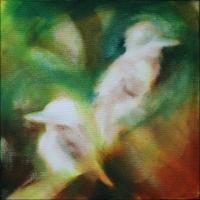 |
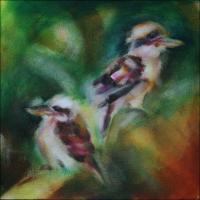 |
||
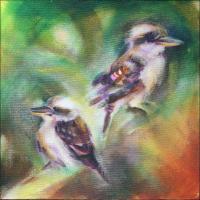 |
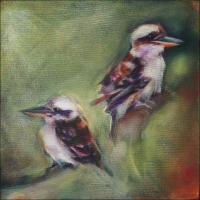 |
||
There is a work phase where, once details are added or changes made to one area, every other thing in the picture needs to be brought to the same level of quality: quality meaning style and feeling of the features. I don’t regret proceeding, but it does mean extra effort to solve all the new challenges, and usually while attempting to solve those new ones arise. Other professionals would say this is overworking, but it really depends on what your intentions are as an Artist, and what motivates the work. If risks are not taken sometimes, a painting may never be all that it could be. Phrases we tend to cling to like “less is more” are not written in stone; sometimes more is more…learning is a good thing!
In landscapes details are best left for the imagination, whereas painting animals, birds or other creatures, a purpose needs to be clearer. Is the intention to portray character through shape and silhouette? other traits? specific markings? Is it the main focus or only a part of the whole? Computer tools are also useful in playing with colors and other possibilities.
Neighborhood Heron
Thursday, March 19th, 2009
Neighborhood Heron, 11H x 11W x 3D inches acrylics on canvas, wrapped sides painted. Frame unnecessary. Hang on a wall or display on a flat surface. Signed on the side so as not to impose on the composition.
Sold but a similar piece can be recreated upon request. Please allow 7 days to paint before shipping.
Started with a base coat of very watered down translucent pthalos green mixed with cerulean blue. Spraying rubbing alcohol over a damp painted water-based surface then allowing it to dry without moving it will create starry, spotty textures. Salt shaken over wet paint allowed to dry, then wiped off with a dry cloth will produce similar effects.
Alcohol loosened up the entire surface of paint, so using fingernails under a damp smooth t-shirt cloth, I rubbed off areas to shape the heron and winter trees. This represents a super argument for the wingin’ it methods!
In college I took a pottery course for one semester, and the thing I remember most is the instructor saying how it’s a good idea to allow some of the raw characters of the materials we work with to remain and “speak” without trying to smooth over and perfect everything. She was of course referring to clay, but over the years I’ve found that it applies to many other mediums also. In Heron, the branches extend into the body of the bird, connecting it to its environment. The effect also does a subtle play on the motion of its flight too.
Showcased in the J. Mane Gallery’s Fins, Feathers and Fur 2020 exhibition.
Wrens Move In
Saturday, August 2nd, 2008
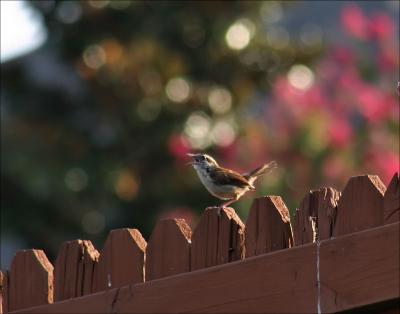
Alain built a birdhouse during Spring hoping to start a bird-cam, but no luck until today when these little wrens moved in. We’re really excited to get the bird-cam working and hopefully watch them raise their family. According to the Peterson Field Guide they look like Carolina Wrens.
